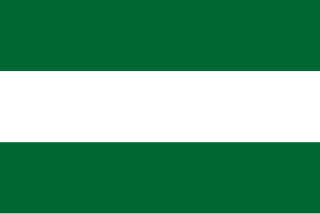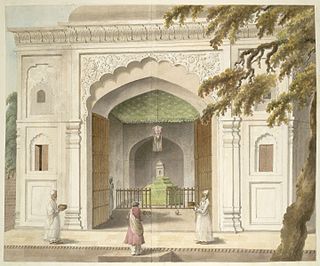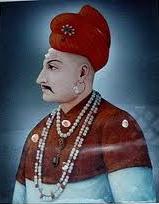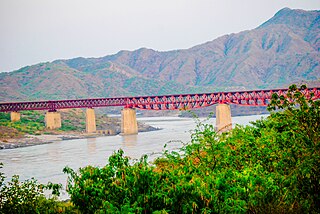
Ahmad Shāh Durrānī, also known as Ahmad Khān Abdālī, was the founder of the Durrani Empire and is regarded as the founder of the modern state of Afghanistan. In July 1747, Ahmad Shah was appointed as the King of Afghanistan by a loya jirga in Kandahar, where he set up his capital. Assisted by a council of nine advisers from various Afghan tribes, Ahmad Shah pushed east towards the Mughal and Maratha Empires of India, west towards the disintegrating Afsharid Empire of Iran, and north towards the Khanate of Bukhara of Turkestan. Within a few years, he extended his control from Khorasan in the west to Kashmir and North India in the east, and from the Amu Darya in the north to the Arabian Sea in the south.

The Durrani Empire, also called the Sadozai Kingdom and the Afghan Empire, was an Afghan empire founded and built by Ahmad Shah Abdali in parts of Central Asia, the Middle East and South Asia. At its maximum extent, the empire ruled over the modern-day countries of Afghanistan and Pakistan, as well as parts of northeastern and southeastern Iran, eastern Turkmenistan, and northwestern India. Next to the Ottoman Empire, the Durrani Empire was the greatest Muslim empire of the second half of the eighteenth century.

The Third Battle of Panipat took place on 14 January 1761 at Panipat, about 97 km north of Delhi, between the Maratha Empire and the invading Afghan army, supported by four Indian allies, the Rohillas under the command of Najib-ud-daulah, Afghans of the Doab region, and the Nawab of Awadh, Shuja-ud-Daula. The Maratha army was led by Sadashivrao Bhau who was third in authority after the Chhatrapati and the Peshwa. The main Maratha army was stationed in Deccan with the Peshwa.

The Maratha Empire or the Maratha Confederacy was a power that dominated a large portion of the Indian subcontinent in the 18th century. The empire formally existed from 1674 with the coronation of Shivaji as the Chhatrapati and ended in 1818 with the defeat of Peshwa Bajirao II at the hands of the British East India Company. The Marathas are credited to a large extent for ending Mughal Rule over most of the Indian subcontinent.

Rohilkhand is a region in the northwestern part of the Uttar Pradesh state of India, centered on Rampur, Bareilly and Moradabad divisions. Part of the upper Ganges Plain, the region is named after the Rohilla tribe who are Pashtun. The region was called Madhyadesh in the Sanskrit epics Mahabharata and Ramayana.

Shrimant Peshwa Balajirao Bhat, also known as Nana Saheb, was the 8th Peshwa of the Maratha Empire in India. He was appointed as Peshwa in 1740 upon the death of his illustrious father, the Peshwa Bajirao I.

Attock, formerly known as Campbellpur, is a city founded during the British era located in the north of Pakistan's Punjab Province, not far from the country's capital Islamabad. It is the headquarters of the Attock District and is 61st largest city of Pakistan by population. The city was founded in 1908 several miles southeast of the older city of Attock Khurd, which had been established by the Mughal Emperor Akbar in the 16th century, and was initially named in honour of Sir Colin Campbell.

Raghunathrao Bhat was the 11th Peshwa of the Maratha Empire for a brief period from 1773 to 1774.

Bala Hissar, also spelt Bala Hisar, is a historic fortress located in Peshawar, Khyber Pakhtunkhwa, Pakistan. First mentioned by 7th-century explorer Xuanzang, the fort was used as a royal residence for the Durrani Empire since December 1747, when Ahmad Shah Durrani conquered Peshawar. The Maratha Empire captured it after the Battle of Peshawar in 1758. The Sikhs reconstructed the fort after capturing Peshawar in March 1823. In 1849, the British East India Company reconstructed the fort's outer walls.

The Durrani dynasty was founded in 1747 by Ahmad Shah Durrani at Kandahar, Afghanistan. He united the different Pashtun tribes and created the Durrani Empire with his Baloch allies, which at its peak included the modern-day Afghanistan, Pakistan, as well as some parts of northeastern Iran, eastern Turkmenistan, and northwestern India including the Kashmir region. The Durranis were replaced by the Barakzai dynasty during the early half of the 19th century.

The History of Khyber Pakhtunkhwa refers to the history of the modern-day Pakistani province of Khyber Pakhtunkhwa, including the former Federally Administered Tribal Areas, which has colloquially been referred to as Pashtunistan. The earliest evidence from the region indicates that trade was common via the Khyber Pass; originating from the Indus Valley Civilization. The early people of the region were a Vedic people known as the Pakthas, identified with the modern day Pakhtun peoples. The Vedic culture reached its peak between the 6th and 1st centuries B.C under the Gandharan Civilization, and was identified as a center of Hindu and Buddhist learning and scholarship.

The Afghan–Sikh wars were a series of wars between the Islamic Durrani Empire, and the Sikh Empire. The conflict had its origins stemming from the days of the Dal Khalsa.

The Battle of Peshawar took place on 8 May 1758 between Maratha Empire and the Durrani Empire. The Marathas were victorious in the battle and Peshawar was captured. Before that, the fort of Peshawar was being guarded by Durrani troops under Timur Shah Durrani and Jahan Khan. When Raghunathrao and Malhar Rao Holkar had left Punjab they appointed Tukoji Rao Holkar as their representative in this area of the sub-continent. He along with Sardar Santajirao Wable and Khandoji Kadam defeated the Afghan garrison. The victory in this battle is considered a great success for Marathas as now their rule had extended to the border of Afghanistan, located 2000 km far from their capital Pune.
The Maratha conquest of Northwest India occurred between 1757 and 1759, when the Maratha Empire captured the northwestern parts of the Indian subcontinent from the Afghan Durrani Empire. Despite Maratha rule in this region being short-lived, it had long-lasting effects upon the future geopolitics of the Indian subcontinent.

Dattaji Rao Shinde, also known as Dattaji Rao Scindia, was the second son of Ranoji Rao Shinde and Maina Bai, alias Nimba Bai. His elder brother was Jayappaji Rao Shinde and his younger brother was Jyotiba.

Timur Shah Durrani, was the second ruler of the Durrani Empire, from 16 October 1773 until his death in 1793. An ethnic Pashtun, he was the second eldest son of Ahmad Shah Durrani.
The Battle of Delhi in 1757 also referred to as the Second Battle of Delhi, was a battle fought on 11 August 1757 between the Maratha Empire under the command of Raghunath Rao and the Rohillas under the command of Najib-ud-Daula, who was under the Afghan suzerainty and simultaneously the "Pay Master" of what remained of the Mughal Army. The battle was waged by the Marathas for the control of Delhi, the former Mughal capital which was now under the control of Rohilla chief Najib-ud-Daula, as a consequence of the fourth invasion of India by Ahmad Shah Abdali.
Krishna Rao, also known as Shamsher Bahadur I, was a ruler of the Maratha dominion of Banda in northern India. He was the son of Bajirao I and Mastani.
Ahmad Shah Durrani invaded India eight times between 1748 and 1767. After the assassination of Nadir Shah, Ahmad Shah Durrani succeeded the throne of Afghanistan and started plundering wealth from nearby regions. In the Chota Ghalughara and Vada Ghalughara Abdali managed to massacre many through ambush, but in the end, Abdali retreated when he encountered the Sikhs on his way to India on the banks of river Chenab. That was his last invasion he would ever do as shortly after he died. After Durrani returned to Afghanistan, the Sikhs rebelled and annexed several cities in the Punjab region. His repeated incursions destroyed the Mughal empire and at Panipat, dealt a major blow to Maratha pretensions in the North and created a power vacuum. His objectives were met through the raids and caused political issues in India.
The Battle of Lahore was fought between the Durrani Empire and the Maratha Empire, who were assisted by the forces of the local Sikh Misls such as the Sukerchakia Misl and the Ahluwalia Misl of the Punjab in 1759.














